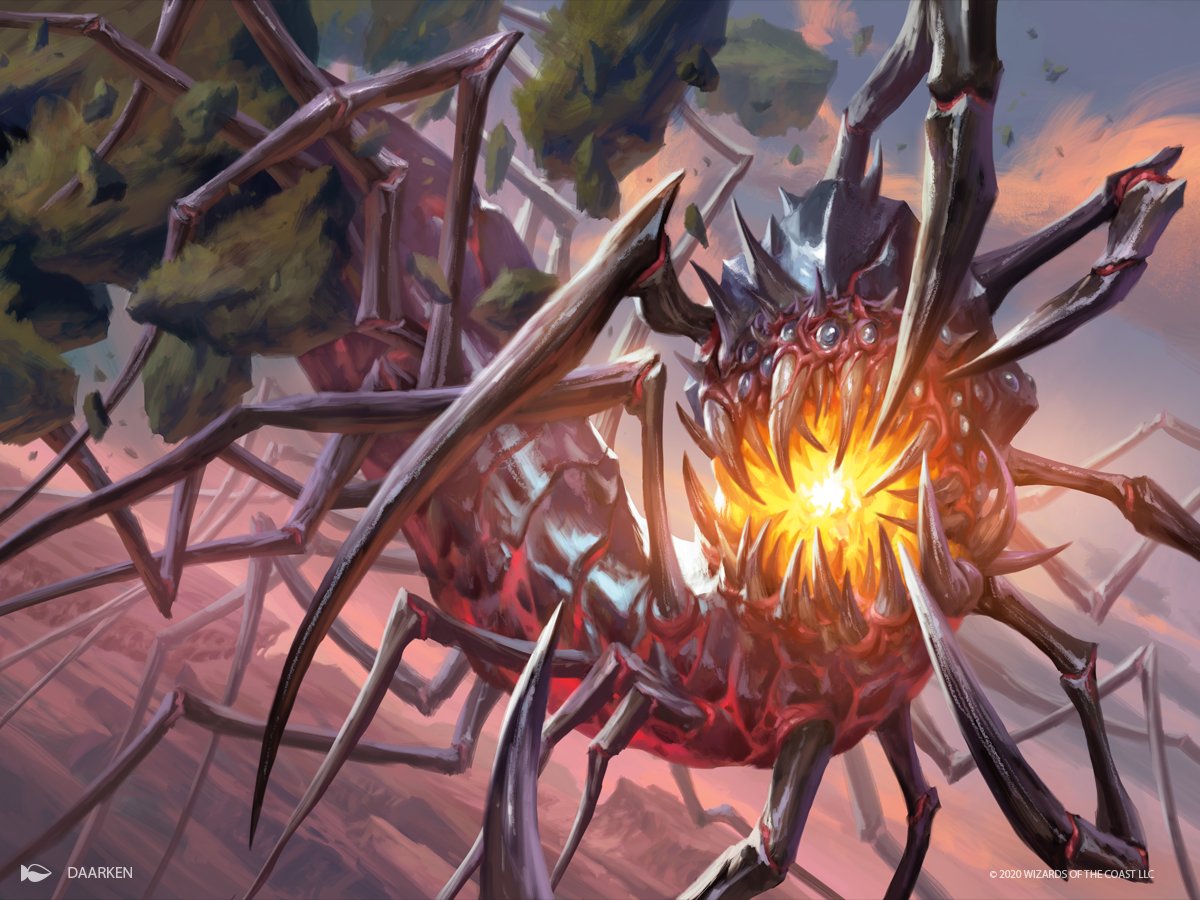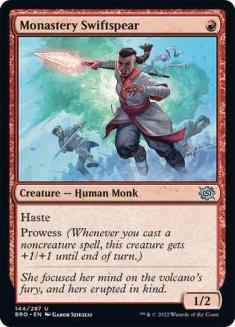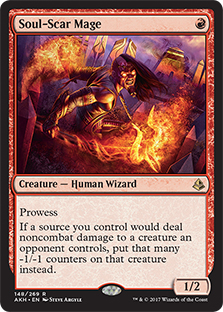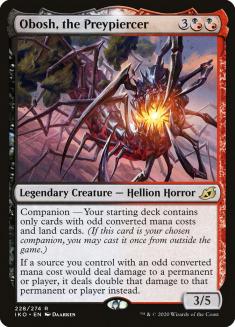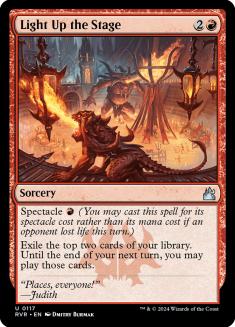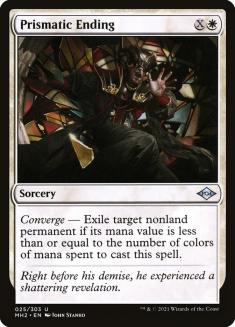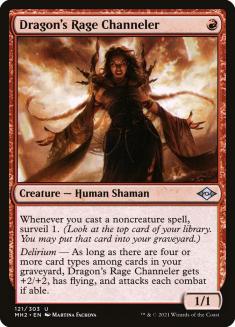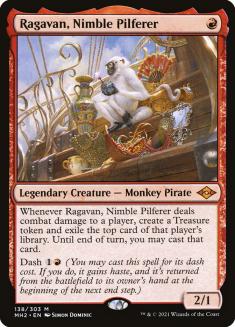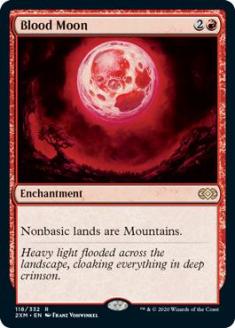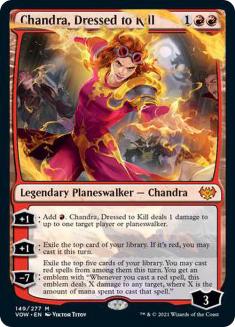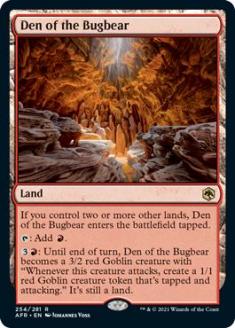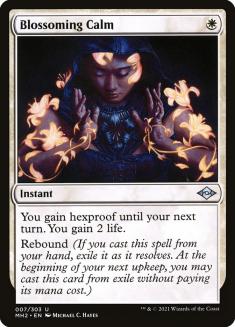Prowess has been a powerful archetype in Modern for a while now. Old-school versions ranged from Bedlam Reveler midrange all the way to Arclight Phoenix and Desperate Ritual combo. Most builds featured two creatures that I would consider the glue that holds the deck together:
These two creatures offer high amounts of damage output for a small investment. Every burn spell you cast deals an extra point of damage. Blocking them is difficult because there are so many free and cheap spells at your disposal. A single Lava Dart can mean a ton of extra burst damage thanks to just casting a high number of raw spells. In essence, casting raw spells is how you create velocity in this type of deck, since every noncreature equates to a buff for these two threats.
In the olden days, the best way to beat Prowess wasn’t with lifegain spells, but instead putting an emphasis on killing their creatures. Lava Dart isn’t that threatening unless there’s a creature getting buffed by it. When building this style of deck, you can go a number of ways, but traditional builds were lighter on creatures in favor of more “combo-style” turns. Having fewer creatures meant you’d draw more noncreature spells, thereby pumping your one-drops to the best of your ability. If an opponent had a ton of dedicated cheap removal, your deck basically fell apart.
Lurrus of the Dream-Den changed everything. The “Companion Summer” where they were functioning at 100% was ludicrous for aggro decks because Lurrus of the Dream-Den was maybe the most powerful card ever printed. Thanks to the companion mechanic, it started in your hand, and the deckbuilding “cost” was tame. Aggro decks put it to its best use, since their threats naturally have low costs, and ultimately the entire landscape changed. Prowess decks moved to all one- and two-drops and didn’t rely on Bedlam Reveler anymore.
Even after the nerf to companions, the decks stayed lower to the ground and still played companions. They’re just that damn good! While Lurrus was the go-to companion, some people have been experimenting with a version that uses Obosh, the Preypiercer, and I have been really impressed by both the explosive power in the early turns and the late-game that Obosh can foster.
In a pinch, these companions can be used with Incarnations like Fury, which gives them a little more usefulness even if they are a lot more expensive than they used to be. For the record, Solitude has already shown me how important it is to play a companion. Yorion, Sky Nomad is great in a deck that doesn’t have a ton of blink targets, as long as you have Solitude or something similar to pitch it to. That extra card goes a long way in a deck that plays free spells requiring a pitch, since that free spell can be changed to costing three mana instead of an extra card. Fury with Obosh is a no-brainer.
Osh Gosh Obosh
A new version of Prowess has come to fruition thanks to streamer D00mwake, and has been tearing up the Leagues on Magic Online over the last week. New additions from Modern Horizons 2 have given the deck some juice, and this build has been putting those new threats through the paces. Before we go too far, let’s start by taking a peek at Modern’s newest aggro deck: Boros Prowess (Obosh)!
Creatures (18)
Planeswalkers (3)
Lands (15)
Spells (24)
Sideboard

Cheating on mana costs is an old tradition in Modern. Companions and cascade are just two examples of hoops we have to jump through with cards that have alternate casting costs. Mana value and how much mana you actually spend to cast the spell are different things, so finding spells that function for cheaper than advertised is important for getting the max value out of your game pieces. In this instance, we’re going to see Obosh’s curve of 1-3-5 cheated slightly in two ways.
Normally costing five mana, Fury’s pitch effect lets you cast this game-breaker of a spell for zero mana while still sitting in the mana value trench necessary to play Obosh. Its spray ability allows you to contain creature rushes from the opponent for a small investment. The companion ability can also turn “pitch a red card” to “pay three mana,” making this a pretty disgusting Arc Lightning-type effect.
Light Up the Stage costs three mana normally, but it can be cheated to cost only one when you’re attacking or dealing early damage with Lava Dart. Cards that sit on the right numbers for Obosh and cost less than advertised are important tools for deck construction, and often offer alternatives to the usual fare. Here, we have Light Up the Stage acting as a card advantage engine for very cheap. In fact, they recently printed this exact effect at two mana, but Obosh prevents us from playing it.
Prismatic Ending has a mana value of one until you start pumping mana into it. That means Prismatic Ending can kill two-mana permanents, even though that kinda goes against the spirit of Obosh. Regardless, the rules are the rules, and playing Prismatic Ending here is welcome, as Mono-Red has a lot of trouble dealing with weird permanents. Prismatic Ending is a phenomenal card that unlocks a lot of interaction potential for decks and colors that are lacking.
Threat Density and the Modern Horizons 2 Brick Houses
As we discussed earlier, Prowess has previously suffered from a lack of threat density. Soul-Scar Mage and Monastery Swiftspear are excellent creatures, but they can only do so much. You have to play more creatures if you want to beat removal, but those creatures have traditionally been weaker than the two one-drops with prowess. Well, since the arrival of Modern Horizons 2, that isn’t necessarily the case anymore
These two creatures are possibly the best red creatures ever printed. Among the four different one-mana creatures in the deck, you’ll find the best of the best depending on what you’re trying to do with them. I’d argue that Goblin Guide might be up there on the list, but it just doesn’t really mesh with the play-style we’re going for.
Dragon’s Rage Channeler is not at its best in this archetype, but it is still excellent. It usually shines in decks that can play Mishra’s Bauble, but Obosh keeps us from doing that. We’re still playing Dragon’s Rage Channeler in spite of this, and it functions quite well. A single Lava Dart can do some cool tricks, and your raw number of card types is actually pretty high, so getting delirium shouldn’t be too difficult.
Ragavan, Nimble Pilferer is a different animal. We can clear their blockers easily, which means our opponents will need spot removal instead of blockers. If they don’t have either, you can ramp right into a powerful three-drop. Most Ragavan decks hover around the one-mana mark, and they use the Treasures to cast more spells instead of bigger spells. This deck doesn’t do that, and has quite a few dazzlers in the three-drop slot.
Ramping into Blood Moon is hilarious in a number of matchups. The powerful enchantment offers a dagger for land-based strategies, yet poses problems for many archetypes that aren’t reliant on their lands to win the game. Screwing your opponent via colors is a tried-and-true tradition of red decks, and we’re keeping that tradition alive by playing the full four copies in our maindeck.
There has been a return to land-based decks in Modern, which in turn has given new life to the hateful enchantment. When Primeval Titan and the Urzatron are prevalent, Blood Moon becomes an “I Win” button in some matchups. With Ragavan leading the party and putting it out ahead of schedule, this Prowess deck gets some blisteringly fast wins even outside of the combat phase.
The other three-drop that we’re pushing out early with Ragavan is Chandra, Dressed to Kill, the newest red planeswalker. It’s incredibly how quickly public opinion turned around on this one. I didn’t think it was all that good when I first saw it. In essence, it looked like Chandra, Torch of Defiance that was one mana less but with the “kill an opposing creature” removed. That’s a big effect to lose, but the one-mana difference is what makes it castable in a deck featuring Obosh.
Chandra’s abilities generate mana, deal damage, and allow you to play more cards from the top of the deck. If left unchecked, it can be any type of engine you want. With all the removal at our disposal, it shouldn’t be that hard to keep it protected, especially when our opponents will be wasting a ton of time trying to kill all our absurd one-mana threats.
There’s something to be said about threat overload, and Chandra, Dressed to Kill is a perfect follow-up to a bunch of creatures that are “must-kills.” It hits on a different wavelength and can get out of hand in a hurry. It doesn’t die to traditional spot removal, dodges Lightning Bolt, and only ticks up. It’s the perfect planeswalker for this archetype specifically because it fits the bill for Obosh.
What the Hell is a Bugbear?
The last year has given Prowess some really big upgrades in nearly every department. We’ve discussed some of the threats and some of the removal, but what about the lands and sideboard?
I don’t know what a Bugbear is, and at this point I’m afraid to ask. What I do know is that Den of the Bugbear is outrageous. It’s rare that we get a creature-land that enters the battlefield untapped, and one that also taps for colored mana is even rarer. Long gone are the days of Faerie Conclave and Ghitu Encampment. Now we’re hitting the ground running on the first turn, and that land will be one of the cards that helps you close the game in the later turns.
Den of the Bugbear reminds me a lot of Raging Ravine, both in terms of efficiency and damage output. The cost to activate is similar, and the extra body it creates acts like the +1/+1 counter you would see on Raging Ravine. Since Raging Ravine is one of the best creature-lands ever printed, having them be comparable this early is a big deal. We’ve already gotten to the point where these new creature-lands are seeing play in Modern, and this one might be the best I’ve ever seen outside of Mutavault. Considering it taps for colored mana, it might ultimately end up being the best creature-land of all time for aggressive decks.
The sideboard has also gotten a neat little upgrade, and I would consider it borderline ludicrous in the right matchup. Burn is one of my most hated decks in Modern, but I think that’s just because I enjoy playing decks that are terrible against Eidolon of the Great Revel.
One mana for four life and the potential to counter a burn spell is hilarious. Not only does giving you hexproof potentially counter a spell, the rebound ensures you get a little extra life boosty along the way. There are more uses for this card than countering Lava Spike, but that will be the primary function. I’ve watched Blossoming Calm counter activations from Goblin Charbelcher. I’ve seen it stop Grapeshot in its tracks. I’ve even seen it prevent Thoughtseize from stealing a key piece of the puzzle. Blossoming Calm really does it all.
One mana to gain four life is already a pretty decent effect for stemming the bleeding from aggro decks. While it won’t usually get the job done on its own, it is certainly a potent effect for just one mana. I’ve died to enough Boros Charms in my day to pocket three or four copies of Blossoming Calm for later use.
Merry Prowess-mas
Modern is chock-full of sweet, playable decks. It’s awesome to see long-lost archetypes making a comeback, even if they’re getting a big facelift. Monastery Swiftspear and Soul-Scar Mage are the original Dynamic Duo, but Ragavan and DRC are stellar in their own right. Put’em all together and you’ve basically got The Beatles.
Prowess is a deck whose success often hinges on the strength of Lava Dart. If there are a ton of targets running around, Prowess is usually quite strong. Lava Dart is often used as a damage engine for your prowess creatures, but giving it new life by killing Ignoble Hierarch or opposing Ragavans is what mutates this deck from mediocre to monster.
I love the additions from Modern Horizons 2, but it’s no lie that this deck has changed dramatically as a result of the last six months’ worth of cards. And so it goes, decks change with the tide, and powerful new cards carve the face of the format. Boros Prowess just makes me feel feelings I haven’t felt in a long while. I didn’t know how badly I missed Light Up the Stage until Ragavan let me fuel it fully on the second turn. Ragavan is truly a gift to red mages everywhere.
If you’re big into Lava Dart, you don’t wanna miss out on this build. It’s fresh, fun, and full of old favorites. It really is the most wonderful time of year. Merry Prowess-mas, you old Building and Loan!

